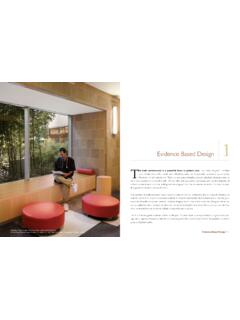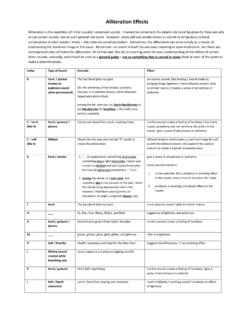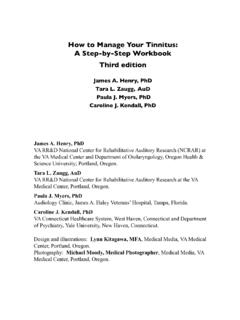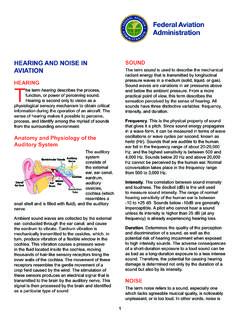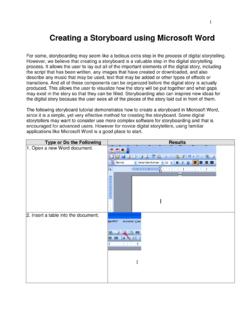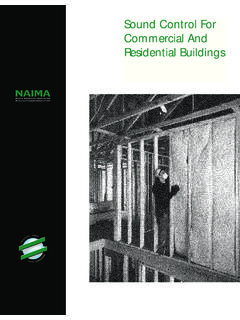Transcription of Sound Control for Improved Outcomes in Healthcare Settings
1 Sound Control forImproved Outcomes inHealthcare SettingsAnjali Joseph, , Director of Research, The Center for Health DesignRoger Ulrich, , Professor, Center for HealthSystems and Design, Texas A&M UniversityThis paper was funded by a grant from the Robert Wood Johnson Paper #4 January 2007 The Center for Health Designis a nonprofit research and advocacy organ-ization whose mission is to transform Healthcare Settings into healing environments that improve Outcomes through the creative use of evidence-based design. We envision a future where healing environments are recog-nized as a vital part of therapeutic treatment and where the design ofhealthcare Settings contributes to health and does not add to the burdenof Robert Wood Johnson Foundationfocuses on the pressing health andhealthcare issues facing our country.
2 As the nation's largest philanthropydevoted exclusively to improving the health and Healthcare of allAmericans, the Foundation works with a diverse group of organizationsand individuals to identify solutions and achieve comprehensive, meaningful and timely change. For more than 30 years, the Foundation has brought experience, commitment, and a rigorous, balanced approach to the problems thataffect the health andhealthcare of those it serves. When it comes to helping Americans lead healthier lives and get the care they need, theFoundation expects to make a difference in your lifetime.
3 For more infor-mation, visit :Lisa Richter, Richter CommunicationsGraphic Design: Glenn Ruga, Visual Communications 2007 The Center for Health Design1850 Gateway BoulevardSuite 1083 Concord, CA purpose of this paper is to examine how different aspects of Sound noise, speech priva-cy, speech intelligibility, and music impact patient and staff Outcomes in Healthcare Settings and thespecific environmental design strategies that can be used to improve the acoustical environment ofhealthcare Settings . Methods: This paper provides a literature review of peer-reviewed journal articles, research reports, andbooks published in medicine, psychology, architecture, and acoustics publications.
4 Keywords used tosearch for articles included noise in hospitals, reverberation, sleep, patient privacy, HIPAA, speech intel-ligibility, speech security, and music . Key findings:Hospitals are extremely noisy, and noise levels in most hospitals far exceed recommendedguidelines. The high ambient noise levels, as well as peak noise levels in hospitals, have serious impactson patient and staff Outcomes ranging from sleep loss and elevated blood pressure among patients toemotional exhaustion and burnout among staff. Poorly designed acoustical environments can pose a seri-ous threat to patient confidentiality if private conversations between patients and staff or between staffmembers can be overheard by unintended listeners.
5 At the same time, a poor acoustical environmentimpedes effective communication between patients and staff and between staff members by renderingspeech and auditory signals less intelligible or detectable. This has serious implications for patient safe-ty. A well-designed acoustical environment is critical in addressing these problems related to noise andcommunication of information. Noise levels can be effectively reduced by providing single-patient bed-rooms, installing high-performance Sound -absorbing acoustical ceiling tiles, and removing or reducingloud noise sources on hospital units.
6 Also, acoustical ceiling tiles improve speech intelligibility by reduc-ing Sound reverberation and increase speech privacy by reducing Sound propagation into adjoining measure for increasing patient confidentiality is providing private rooms enclosed with walls thatgo up to the ceiling, thereby preventing voice travel through ceilings in spaces where private patientinformation is likely to be shared. A large body of research also shows that music therapy is effective inreducing anxiety and distress among patients in many different types of Healthcare .
7 Sound Control is critically important in Healthcare Settings , and different environmentaldesign strategies have proven successful in mitigating negative effects of noise while allowing effectiveyet private verbal Control FOR Improved Outcomes IN Healthcare Settings / 1 IntroductionSound, in its different manifestations, can have profound impacts on patients, staff, and visitors in hos-pitals ranging from soothing and therapeutic to stressful and disturbing. It is well-established thatmost hospitals are extremely noisy, well-exceeding recommended guidelines for noise levels (Busch-Vishniac et al.)
8 2005). Noise, which is widely defined in the research literature as unwanted Sound , canbe detrimental to patient and staff health. Another aspect of Sound speech intelligibility and audibili-ty is essential to communication between patients and staff and between staff members in the other hand, if confidential patient information being discussed between patient and staff mem-bers or between staff members is overheard by others, it can pose a serious breach of patient confiden-tiality, and issues of speech security and speech privacy come to the fore.
9 These different aspects ofsound, ranging from stressful noise to pleasant music and speech intelligibility to speech privacy, sug-gest the importance of designing and controlling the environment to prevent the transmission of unwant-ed Sound yet maximize speech intelligibility between persons whoneed to communicate with each other. These issues associated with Sound Control and transmission areinterrelated, and different environmental design strategies haveproven successful in mitigating negative effects of noise whileallowing effective verbal communication.
10 The purpose of thispaper is to examine how these different aspects of Sound noise,speech privacy, speech intelligibility, and music impact patientsand staff in Healthcare Settings and the specific environmentaldesign strategies that can be used to improve the acoustical envi-ronment of Healthcare Settings . Noise in Healthcare Settings There is a large body of literature that clearly spells out the problem that is pervasive in hospitals theworld over hospitals are extremely noisy. The World Health Organization (WHO) guideline values for con-tinuous background noise in hospital patient rooms are 35 dB(A) during the day and 30 dB(A) at night,with nighttime peaks in wards not to exceed 40 dB(A)i(Berglund et al.)




